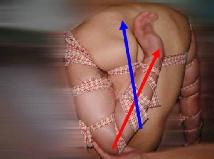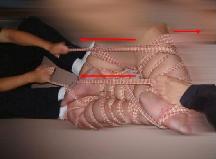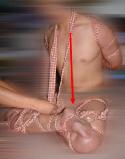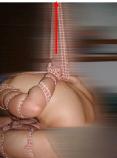(Clearwisdom.net) After the persecution of Falun Gong started in 1999, Huaduchini Forced Labor Camp in Guangzhou City has specialized in illegally detaining and persecuting Falun Gong practitioners, and is the scene of some of the most heinous crimes.
The Clearwisdom.net article from August 28, 2004, entitled "The Truth of the Persecution of Dafa Practitioners by Guangzhou First (Huaduchini) Forced Labor Camp" exposed only a small portion of what has actually taken place there, and it is far from a complete picture of the facts. Furthermore, the actual list of Falun Gong practitioners that have been tortured there far exceeds the list provided in the article. Huaduchini guards and labor camp employees use several ways to torture practitioners. The prison guards often mask the brutality of their actions by highlighting the violent actions of the labor camp workers, while the guards appear to be abiding by their promise to "not hit practitioners," and only directing prisoners to carry out the persecution. They attempt to make it seem as though practitioners are going through less torture by perpetrating their crimes late at night, often in remote basement "meeting rooms," but even so, the cries of pain from practitioners being tortured can frequently be heard by other people detained in the labor camp. This type of violence is usually carried out by three or four prisoners, while policemen direct the torture sessions, often attempting to conceal their participation. The materials used in this torture method described below include a strong rope two to three meters in length, cloth-strips typically made from old blankets, old socks, metal hooks, and cleaning rags.
Firstly, the practitioner is forcibly restrained, and then bound at the wrists and ankles. Both arms are then tied using rope to completely encircle the arms, forcing the arms behind the back, and pulling them up tightly. Next the legs are forced into the cross-legged position and tied there. The legs are tied at the knees instead of the thighs in order to cause more pain. Then, ropes are tied around the neck to the legs, forcing the person into the shape of a ball. The mouth is then filled with dirty rags or worn socks, which are secured with string or rope tied horizontally all the way around the head across the mouth, so the victim can't shout out. Finally, another rope is tied to the person's wrists, and the person is hung with this rope from an iron hook on a metal rack. A practitioner might be subjected to this torture for durations ranging from 20 minutes to more than an hour.
Below are photographic illustrations of this torture method. For various reasons, including security considerations, the pictures and descriptions do not reveal certain details, and the features of the person in the illustrations are obscured. Furthermore, the force used to tie up the victim in the pictures is much less than that actually used on practitioners tortured in the labor camp. According to prisoners, this type of torture cannot be withstood by most people for more than ten minutes, and can cause paralysis.
1. The wrists and ankles are bound, concentrating pressure at the joints, and tied so tightly that it often results in extravasated blood (blood escaping the blood vessels into the surrounding tissues), or even necrosis.
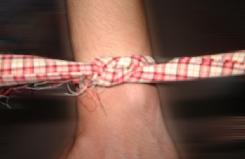 Wrists are tightly bound. |
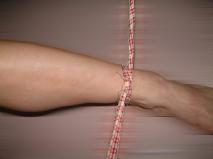 Ankles are tightly bound. |
2. Both arms are tightly bound and completely encircled.
 Strong rope or strips of cloth are used, and both arms are tightly encircled. |
 Both arms are tied behind the back |
3. The arms are twisted, pulled up, and tied behind the back.
Both arms are twisted, pulled up, and tied behind the back. The picture above cannot show the actual brutality of the tying. In the labor camp, the forearm (where the red arrow is) is pulled up and tied to the point where it would be completely pressed to the back (from top to bottom), and would actually be in the position of the blue arrow, and pulled up even higher than shown. When the arm is tied in this position (shown by the blue arrow), the muscles are already severely damaged.
Both arms are twisted and tied behind the back. Ropes are used to pull them up tightly.
In the above picture, the red arrows show the actual position of the two forearms. The blue arrows illustrate the final position the forearms are forced into. (The forearms would form an "11," parallel to each other, as shown by the blue arrows.)
4. The legs are bound.
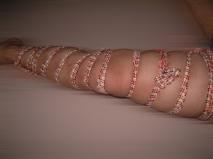 The legs are tightly encircled. |
 Both legs are tied in the cross-legged position, and held in position at the knees. |
 The ankle is tied tightly to the other leg's knee. |
5. A rope is tied to the leg, passed around the neck, the slack is removed, and the rope is tied to the other leg, forcing the person into a ball-shape.
6. Shown here tied in the shape of a ball, bent at the waist, and hung from the wrists.
7. The person is hung from an iron hook. (The arrow shows the direction to the point from which the person is hung.)
8. The practitioner's mouth is filled with socks or rags, and then tied horizontally with rope or string.




